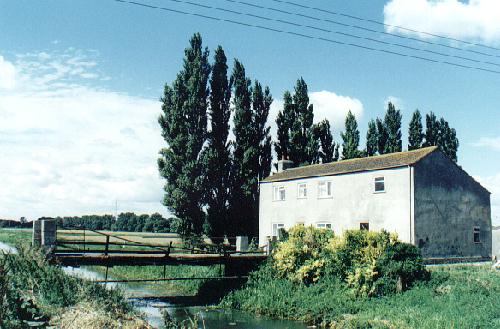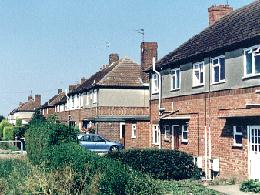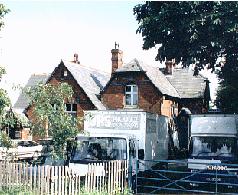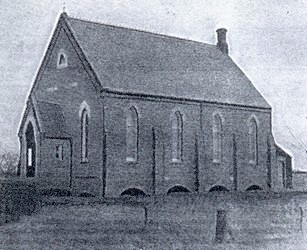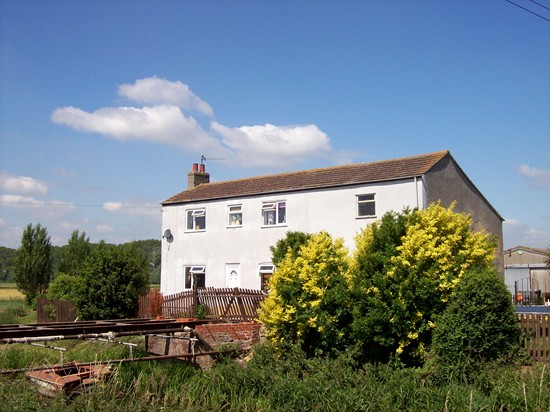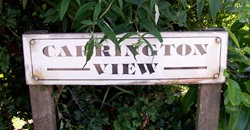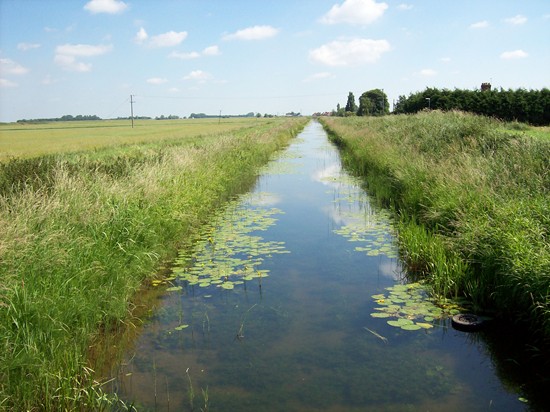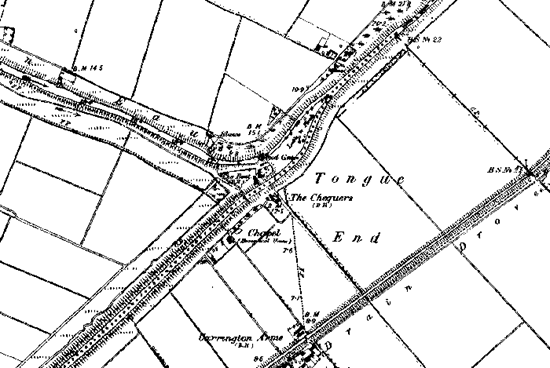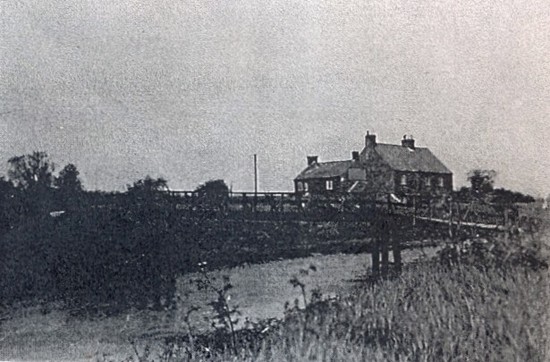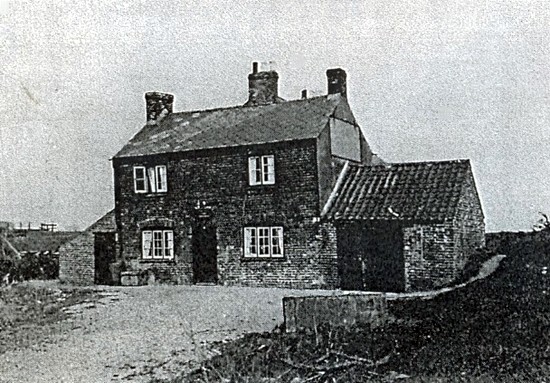|
Tongue End
The most isolated fenland community in the Bourne area is undoubtedly Tongue End, a flat and featureless place with a few houses strung out along one side of the road that runs parallel to the drainage dyke known as the Counter Drain three miles south of Bourne, constructed during the 19th century to carry overflow water from the 400 acres of the Deeping Fen washes and to relieve the River Glen during periods of heavy rain. This place was first mentioned in a document of 1781 describing the nature of the land at this point, where Baston Fen, Thurlby Fen and Bourne Norton Fen, all converge and where the Bourne Eau flows into the River Glen, and it is this geographical feature that gives this village its colourful and descriptive name because the piece of land where the two rivers meet is tongue-shaped, hence Tongue End. Tongue End has always been associated with Bourne but was isolated from the town because the two were separated by the River Glen until the early 19th century when a new bridge was erected. The Stamford Mercury reported on Friday 18th August 1843: "We congratulate the inhabitants of Bourne and Deeping Fen on an improvement which is about to be be affected in the communication between those places. It has long been a crying evil that although not more than four or five miles apart, the inhabitants of neither could approach the other without travelling nine or ten miles. Through the liberality and zeal of those interested (more especially one gentleman), a new bridge is about to be erected over the River Glen at or near Tongue End. This will be not only a great convenience but of pecuniary advantage to the trade of Bourne." Tongue
End once boasted four public houses but all have closed. The Boat Inn has gone
and so has the Chequers which was built in the hope of attracting business from
a local railway station on the Bourne to Spalding line but the opportunity never
materialised and the Counter Drain station was built a mile away instead. The
archives also mention another public house named the Tongue End Inn which was
offered to let in April 1832 together with an adjoining bakehouse but this
hostelry did not appear to have survived for very long because there is no
mention of it after 1850.
But spiritual matters played a major part in community life during the 19th century. When the religious census was taken in 1851, Methodist services were being held in one of the houses, according to the Rev John Bowman of Bourne, who went on to report that it had "no title, being a dwelling house. Preaching every alternate Sabbath." This cottage in Mill Drove was owned by Daniel Crompton, a farm labourer, who also used it as a Sunday School while fund raising went ahead to build a permanent chapel with contributions of one penny a week by all who could afford it. After one unsuccessful attempt to build the chapel, in which the walls collapsed after reaching roof level, the stone and slate United Independent Chapel was finally opened in 1865.
The foundation stone was laid at a ceremony on Monday 25th April 1864 by Mr Francis Brown, a solicitor, of Market Deeping, who had donated the site, and the work was finally completed by the following summer. The official opening was a grand occasion, coinciding with the village's Sunday School Festival, and the Stamford Mercury reported the event on Friday 14th July 1865: The opening of the chapel, in conjunction with the 6th annual festival, took place under very favourable auspices on Wednesday last. Two commodious marquees, supplied by Mr Aitken of Peterborough, were erected in Mr Fisher's large meadow. Mr C Roberts again placed at the disposal of the committee the gratuitous use of his boats, seven large corn boats being fitted up for the purpose, in which 370 persons proceeded to Tongue End. The decorations and arrangement of suitable mottoes in the marquees etc were very tasteful. Shortly after two o'clock, the building was formally opened, in the course of which the Rev Percy Strutt, of Spalding, offered up a very fervent prayer, imploring the divine blessing to rest upon the undertaking. In one of the marquees, at ¼ before 3, the Rev T W Aveling, of London, preached a very eloquent sermon, taking for his text the 2nd verse of the 45th Psalm. At a little before 5 (in the other marquee) the public tea commenced, which was effected in twice, between 600 and 700 being accommodated at the first course; the total number who partook of tea was about 1,000, the crockery for which was supplied by Mr J Boyer, without charge. The tea arrangements seemed to be admirably conducted. The tea was followed by the public meeting, presided over by Mr C Roberts, of Bourne. Several agreeable speeches were delivered, for which we are unable to find space. The chairman announced that the estimated cost of the building would be about £420. There had been received towards that object £283 15s. 6d., leaving a balance of £136 15s. 6d. unpaid previous to the commencement of this anniversary. The collections after the sermon in the afternoon and the evening meeting amounted to £19 17s. 9½d.. After this, other donations were promised bringing the total of the day's proceedings (exclusive of the tea) to about £70, so that above half the balance remaining previous to the opening is provided for. The gathering was altogether a very successful one, there being probably not far short of 2,000 persons present at one time. The children had their treat the next day.
In the early 19th century, Sundays in Tongue End were noted for drunkenness and prize fights and rival gangs often arrived from the surrounding villages to take part in these affrays. One such meeting took place on Wednesday 29th January 1845 and the Stamford Mercury reported the following Friday: "A prize fight took place at Tongue End on Wednesday for £10. The contestants were a fellow named Gutteridge, belonging to the parish of Thurlby, and Tansley, of Crowland. Notwithstanding the time and place were kept 'strictly secret', there were not less than 1,000 persons assembled to witness the exhibition. It is said to have been a hard fought battle; and after 50 rounds, which occupied 57 minutes, Gutteridge was declared the victor. Tansley had apparently no chance after the third round. Gutteridge, is is said, is now matched to fight "Potter George". But the building of the chapel ended this disorderly conduct. Sunday meetings were always crowded and there were frequent temperance and revivalist gatherings. The chapel continued in use until the
mid-20th century when it fell into disrepair and the building was eventually
demolished. The Church of England also had a presence with St Michael's Church, built of brick during the early 20th century, but dwindling congregations forced its closure and
after being used for a spell as the village hall, this venture also collapsed
through lack of support and that too was pulled down. A mile
west of Tongue End was Woolley's Mill at Windmill Farm, one of the fifty
windmills listed as working in Deeping Fen in 1763 to drain some 30,000 acres of
farmland. The mill ground corn and other grain brought in by barge along the
River Glen and navvies working on various drainage schemes over the years were
housed there and fed from the adjoining bakery which also supplied residents of
Tongue End. The mill closed in 1912 and has since been demolished.
REVISED MARCH 2015 See also A Country Practice Prize fighting
Go to: Main Index Villages Index |
|||||||||||||||||||||||||||||||

